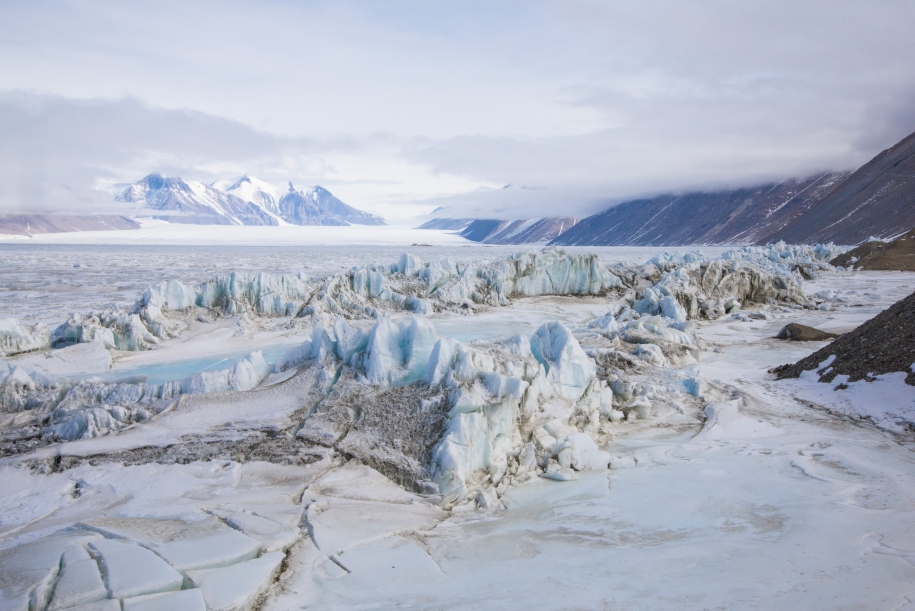

"Giant's Face" Pressure Ridge Beneath the Double Curtain Glacier (2015) A source photo for the 3D file shown in the next two slides. The unusually tall and Baroque-looking sea ice pressure ridges below the Double Curtain Glacier along McMurdo Sound in Antarctica are seldom visited, as they are only accessible by an hour-long trip along the coast via snowmobile from the small New Harbor field camp, where I was staying for a few days with a team of ocean biologists. Multi-year sea ice had been pushed by tides about 20 feet high, and partially melted into strange shapes of unending variety.
Walking in Antarctica
Photographer: Helen Glazer
Exhibit Title: Walking in Antarctica
Location: Antarctica
Walking in Antarctica is a project of photographs and photo-based sculptures, derived from my experiences as a 2015 grantee of the National Science Foundation Antarctic Artists and Writers Program.
I worked out of remote Antarctic scientific field camps and had access to protected areas that can only be entered with government permits or in the company of a skilled mountaineer. Insights from my research and interactions with scientists enhanced my experience of nature there. My goal was to capture and communicate experiences of remote places that few people get to witness in person: frozen lakes, towering glaciers, baroque sea ice formations, inside a frozen ice cave, fields of surreal-looking boulders, and a lively colony of Adélie penguins.
The images range from sweeping landscapes to intimate close ups of small scale features that surprise visitors with vivid depictions of richly articulated and colorful environments that counter the common perception of a bleak, white wasteland.
My past photo projects accompanying field scientists in Antarctica and urban ecologists in the US have heightened my awareness of the multiple factors shaping the land over time. In recognizing that complex patterns in nature express the physical forces at work, I am attuned to the interplay between geology, climate, life forms, and human activity at a specific site.That awareness informs how I select and compose my photographs. I search out surprising incidents and striking visual relationships, which I may underscore with vantage points that foster spatial ambiguities and focus attention on details that typically escape notice.
I strive to convey the wonder and complexity of the natural world to others, hoping to motivate viewers to explore their environment and protect wild places. My study of earth science over the past several years heightened my awareness of the multiple factors shaping the land over time. In recognizing that complex patterns in nature express the physical forces at work, I became more attuned to the interplay between geology, climate, life forms, and human activity in a particular location. That awareness informs how I select and compose my photographs. I search out surprising incidents that convey nature's inexhaustible variety, which I may underscore with vantage points that foster spatial ambiguities and focus attention on details that typically escape notice. Some present sweeping views, others take a more abstract approach, zeroing in on evocative details. I want the experience of looking at my work to be one of enhanced perception of the natural world. I hope these images motivate people to care about addressing the threat posed by climate change to polar environments and support polar science.
Some of the photographs are produced as archival prints. I also makesculptures of landscape forms generated from a series of still photographs taken on site and reconstructed as 3D scans by photogrammetry software. After further editing in 3D modeling software, the resulting digital files become the basis for hand-painted sculptures made with digital fabrication technologies — CNC routers or 3D printers. They provide the viewer a visceral experience of form and texture that differs from the flat image and fixed point of view delivered by a photographic print.
Upon returning from Antarctica, I edited my rich cache of raw material to create archival pigment prints, sculptures generated from photographs of ice and rock formations via digital photogrammetry technology, and an accompanying narrative. The solo exhibition Walking in Antarctica premiered at Goucher College, Baltimore, in 2017, and is currently midway through a five-year tour of the US under the auspices of the Mid-America Arts Alliance ExhibitsUSA traveling exhibition service, with seven bookings in six states to date, the latest of which is April-August 2025 at the University of Oklahoma's Sam Noble Museum of Natural History.
Project Website: https://helenglazer.com/project/walking-in-antarctica-2
ExhibitsUSA Tour Schedule and Rental Information: https://eusa.org/exhibition/walking-in-antarctica/
Email: helen@helenglazer.com
Make Comment/View Comments